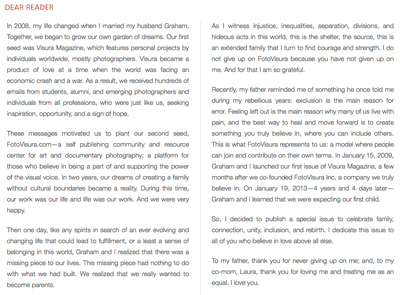
Letter to the Reader, Special Issue
Issue 13
In 2008, my life changed when I married my husband Graham. Together, we began to grow our own garden of dreams. Our first seed was Visura Magazine, which features personal projects by individuals worldwide, mostly photographers. Visura became a product of love at a time when the world was facing an economic crash and a war. As a result, we received hundreds of emails from students, alumni, and emerging photographers and individuals from all professions, who were just like us, seeking inspiration, opportunity, and a sign of hope.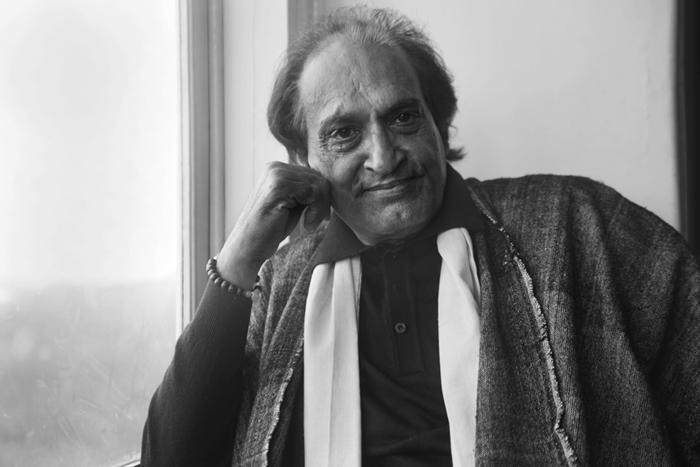
In Conversation with Raghu Rai
Issue 13
Raghu Rai is a New Delhi based photographer born in 1942 in a small village called Jhang, which is now part of Pakistan. Rai started photographing in 1965 at the age of 23. In 1971, Henri Cartier Bresson was very impressed after he saw an exhibition of Rai’s work at Gallery Delpire, in Paris. Rai joined the illustrious Magnum Agency in 1977 as a first Indian photographer.By Alakananda Nag for Visura Magazine

SERENDIPITY | Veronika Marquez
Issue 13
My name is Veronika Marquez and I am an ex-prostitute. This video is my most sincere contribution, gift and offering to the profession of prostitution. In this video, I play Camille, the other “me” who represents my past as a prostitute. I recite a poem written by Jaime Sabines, as an homage to prostitutes who find atonement and convert to saints due to their services rendered. This poem is charged with generosity and virtue, characteristics that I consider to be indispensable to those who work in this profession.
STATE OF SOUND | Milován Radovic
Issue 13
“Latinoamérica” is a song released in 2011 by the Puerto Rican alternative band, Calle 13. Composed by René Perez (band leader alongside his brother Eduardo Cabra), the song is dedicated to Latin America. In 2011, the song won Record of the Year and Song of the Year in the Latin Grammy Awards. The song reflects on the underlying historical, social, and political themes present throughout Latin America. Throughout their nine year trajectory, the band has won 19 Latin Grammy and 2 Grammy Awards.
BETSY SCHNEIDER | Sweet Is The Swamp
Issue 13
I never have been able to take a good ice cream cone-eating picture. I have tried and tried literally dozens of times. Is it that I am too busy eating and balancing the ice cream that I am unable to really focus on making a good picture? Maybe the idea is too cliché, or maybe it has just been bad luck. This summer when I was trying yet again to do this I dropped my Mamiya 7. It wasn't the first time I dropped that camera but the repair people tell me it was the last. That was bad luck. Since then I have been debating whether or not to replace the camera.
DAVID J. CAROL | No Plan B
Issue 13
As a kid, I never traveled anywhere. My parents would go away sometimes, but they never took me along. I was only on a plane once before the age of 20. I was sent alone to Florida one summer to visit my grandparents for a week. I still remember exiting the plane and being hit in the face with that warm, humid and aromatic tropical air. An unfamiliar yet quite exciting experience. To this day I'm still very conscious of the smell, temperature and feel of the air of a new place as I deplane.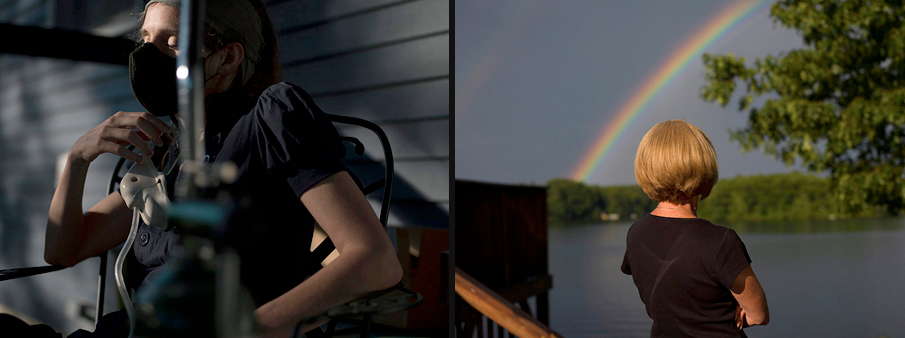
NINA BERMAN | 15 Minutes Apart
Issue 13
Julie, 33, had been a civilian marine engineer on a Navy Vessel in support of Operation Iraqi and Enduring Freedom. Her small size made her perfect to fit into the tight spaces of the engine room, where she was exposed to diesel fumes, chemicals, etc.
LARRY FINK | Apple Of My Eye
Issue 13
"You are the apple of my eye. Enjoy this picture and its carnivorous love." - Larry Fink
JENN ACKERMAN | Trapped
Issue 13
"Trapped" portrays the life and conditions of the prisoners with mental illness at the Kentucky State Reformatory. My hope is that this long term and ongoing project triggers a dialogue not only about prison reform but the mental health crisis in America.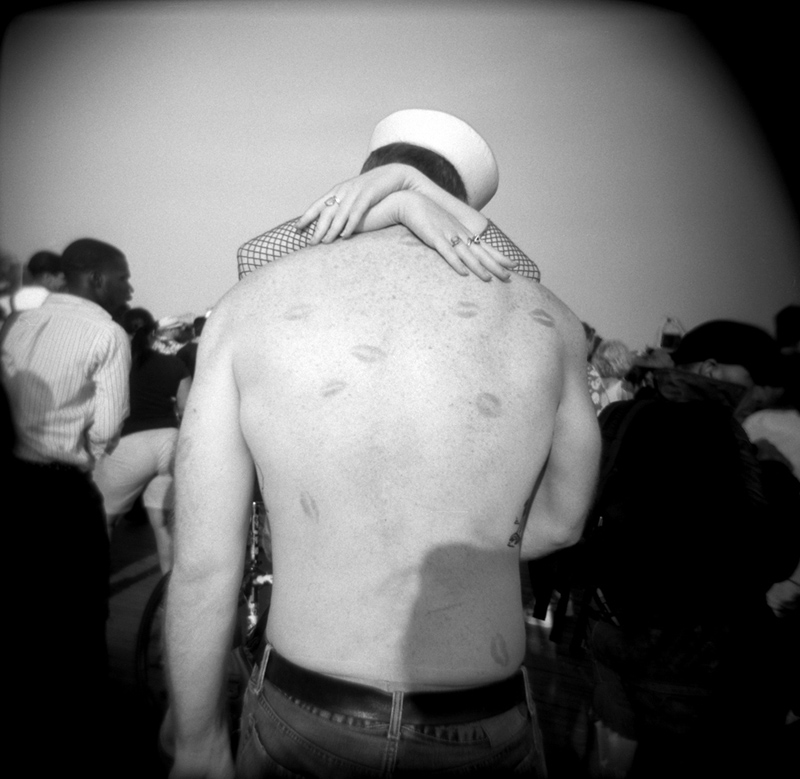
BRIGITTE GRIGNET | I Am Here
Issue 13
Epilogue:It is easy to take what we see for granted and forget how the extraordinary also lies in the ordinary.
Still, it is all right in front of us: life, love, death...
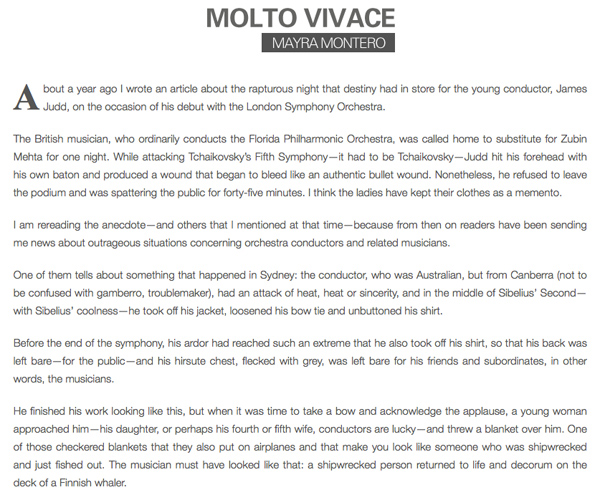
MAYRA MONTERO | Molto Vivace
Issue 13
The British musician, who ordinarily conducts the Florida Philharmonic Orchestra, was called home to substitute for Zubin Mehta for one night. While attacking Tchaikovsky’s Fifth Symphony—it had to be Tchaikovsky—Judd hit his forehead with his own baton and produced a wound that began to bleed like an authentic bullet wound. Nonetheless, he refused to leave the podium and was spattering the public for forty-five minutes. I think the ladies have kept their clothes as a memento.
JEFF JACOBSON | In The USA
Issue 13
I live in a beautiful place. My house is nestled against the base of a mountain; a river runs through my property. State protected wilderness extends for many miles in every direction. My neighbors include bear, deer, fox, bobcats, raccoons, rabbits, rodents of many sizes, hawks, owls, eagles, and birds of all colors. It is idyllic. So, when I come into a city, it feels a bit disorienting. That’s a good place to photograph from.
KERRY MANSFIELD | Aftermath
Issue 13
When I was diagnosed with breast cancer, I was 31 years old. This was 7 years ago.Today, women in their 30’s are the fastest growing group of people with breast cancer in the country. Although it feels like a lifetime has passed since I received treatment, I continue to be haunted by the aftermath of the surgeries, countless combinations of drugs and radical emotional upheavals. The cancer may have left my body, however, its echo never has.

CHARLES HARBUTT | Romance for the Real 5
Issue 13
Christianity was of course the primary art motif in the Middle Ages. Like the Egyptians, the priests claimed to have figured out a system to achieve immortality, eternal life, which they controlled and whose verbal brains legislated the rules, but medieval class structure was a subtext, through the positioning of subjects. God was highest and frequently the largest figure in the frame, cardinals, saints and bishops were next, emperors and other believers next, especially the nobility and at the bottom came the serfs and sinners, often tiny. Art’s purpose was to teach religion’ as Pope Saint Gregory said: The picture is to the illiterate what the written word is to the educated. A detailed list of symbols was promulgated to which artists had to conform. There could no longer be any reference to anything actual because neither the artists nor the image police had ever seen the events being portrayed.




